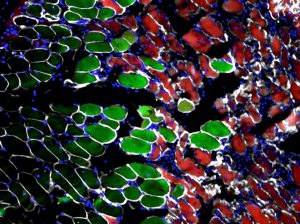Stem cells are pluripotent cells that can continuously generate new stem cell and/or cells that differentiate to a particular phenotype. Normal stem cells are required in tissue regeneration while cancer stem cells are critical in tumor initiation.
The transcription factor ZEB1 promotes the reprogramming of malignant cells toward a stem-like plastic phenotype. Consequently, its expression associates with poorer prognosis in most human cancers. However, the role of ZEB1 beyond cancer remained understudied. We now show that different levels of ZEB1 are required for both tissue homeostasis and cancer progression.
Thus, we found that ZEB1 protects skeletal muscle from atrophy. Using a Zeb1 deficient mouse, we showed that muscle myofibers require full levels of ZEB1 to maintain their normal size. The downregulation of Zeb1 in myofibers to just half of the normal levels enhanced muscle wasting in response to immobilization through repression of so-called atrogenes (Ninfali et al).
We previously reported that induction of ZEB1 in epithelial cells by oncogenic signals (e.g., Wnt, KRas) is not sufficient for ZEB1 to promote tumor progression that requires a super-induction of ZEB1 through additional oncogenic mutations (e.g., RB1 plus KRas, Wnt plus KRas). We have now found that adenoma cells within hypoxic niches divide asymmetrically to produce tumor-initiating cells where ZEB1 is upregulated and prompts the differential distribution of other factors to determine the fate of cancer stem cells upon division (Liu et al).
Reference
